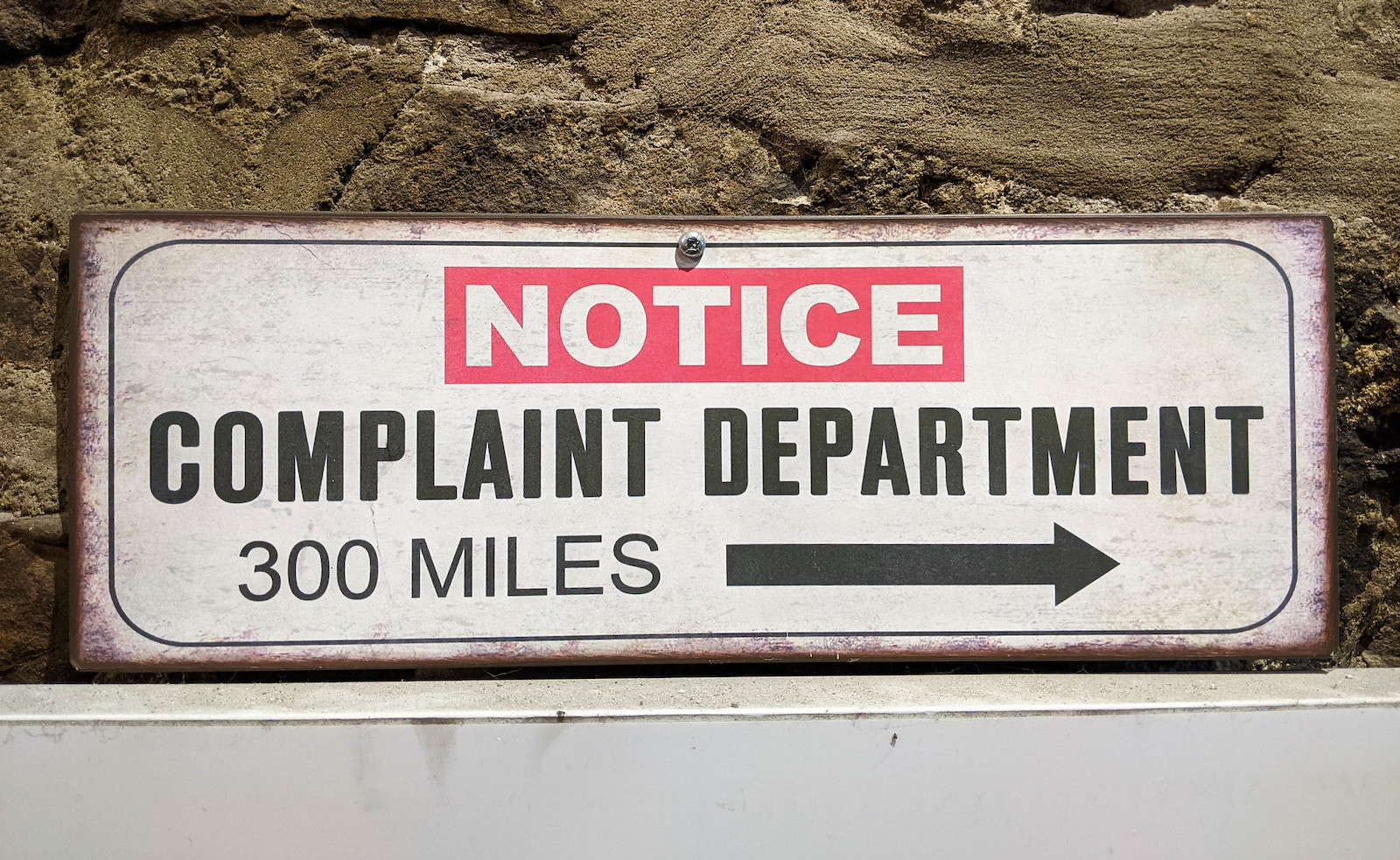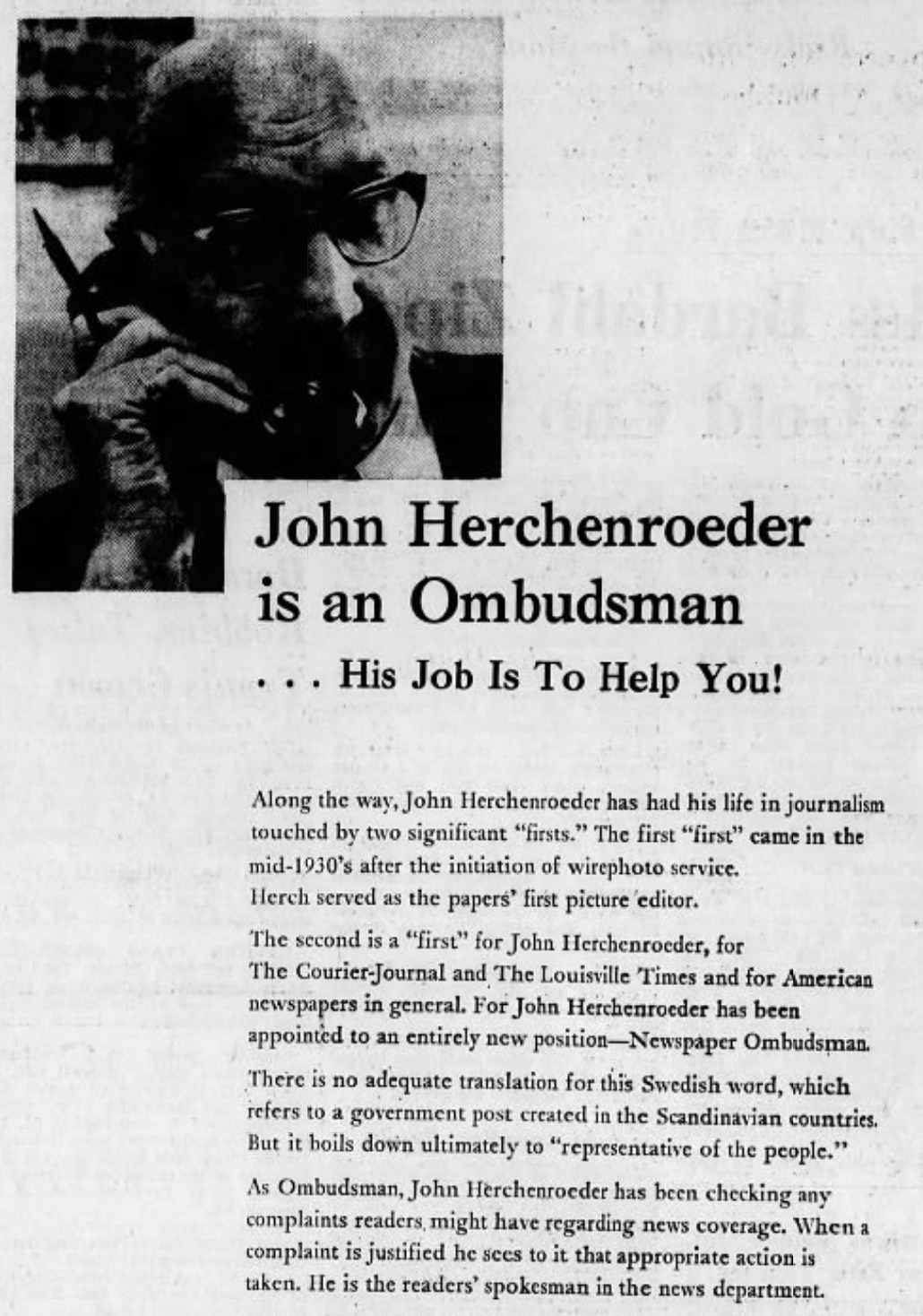
On July 16, 1967, the Louisville Courier-Journal (and its then-afternoon sibling the Louisville Times) became the first American newspaper to appoint an ombudsman — a charming but awkward word taken from Swedish (“representative,” roughly). The concept of having someone designated to take complaints and evaluate their merits had remained confined to Scandinavia until the 1960s, when countries like New Zealand, Canada, and the U.K. all created ombudsman positions in government. But it took C-J publisher Barry Bingham to bring the concept to American newspapers, where it required some explaining.

The Courier-Journal and The Louisville Times today became the first newspapers in the United States to adopt the Scandinavian concept of ombudsman, which has no adequate English equivalent, but which is a sort of public representative.
Barry Bingham, editor and publisher of the newspapers, announced that the ombudsman role was being added to the functions of John Herchenroeder, assistant to the executive editor. Herchenroeder will check all inquiries concerning the accuracy and adequacy of news stories appearing in the newspapers…
“Our papers have always sought to improve their news coverage and their relationship with their readers,” said Bingham “We want all stories to be accurate and complete. There are occasional failures because of misunderstandings, or for any one of a hundred reasons. In all of these instances, John Herchenroeder stands ready to receive inquiries, to seek out the facts, and to move to have corrections carried when they are justified.”
Herchenroeder says that the ombudsman role is an extension of what he has been doing for the last quarter of a century. “I’ve always had an open door and an open telephone line for readers,” he said. “When we miss on something, we always want to know about it. If this doesn’t work, it won’t be for our lack of trying.”
(Spiritually, though, at least some of the credit should go to The New York Times’ A. H. Raskin, who had called for the creation of newspaper ombudsmen — “their own Departments of Internal Criticism” — as a response to the declining number of cities with competing daily papers.)
The idea caught on, and profit-flush monopoly dailies across the country started naming one veteran staffer the point-person for reader complaints, as well as an inside/outside critic of newsroom choices. But when newspaper revenues started to tank, ombudsmen — or public editors, as they’re often now known — were an easy target for budget cuts. (“We pay this guy that much — to complain about us?”) From a peak of about 35, the Organization of News Ombudsmen now lists just six American members, four of them in public media. (And I don’t believe either of the other two would, strictly speaking, count as an ombudsman.)
The decline of this public-facing role has coincided with increased mistrust of “The Media” and increased amplification of reader complaints via social media. The newspaper ombudsman was created as a check on monopoly newspapers’ institutional power; does the role make sense again with that power at an all-time low?
That’s the issue raised in a new paper out today from the Reuters Institute for the Study of Journalism. It’s by former Toronto Star public editor Kathy English, who held that role for a remarkable 13 years.
She still sees an important role for the position but argues it must expand to address some very contemporary issues:
When a news organization commits to an independent public editor, it makes a strong statement about its commitment to trustworthy journalism.
Public editors do the work of overseeing accuracy and fairness and other imperatives of ethical journalism. They can correct your mistakes. They are your public promise of accountability and transparency. They will engage with your news audience and create public understanding of the importance of trustworthy journalism in a world polluted by dangerous disinformation. When appropriate, they will defend your journalists from increasingly hostile invective.
But public editors could — and should — also do more. Here, I call on our “journalistic imagination” to envision a greater role for the public editor in holding journalists to account for diverse, inclusive journalism that is aligned with its moral mission for equality in a liberal democracy.
Just as journalism has failed to reflect the publics it seeks to serve — despite more than 50 years of talking about the need for diversity, inclusion and equality — so too has the role of public editor failed to take hold in global journalism over those same five decades.
Is there a solution that could make the public editor role more relevant, and journalistic diversity a greater reality? Can the role of public editor encompass active responsibility for holding news organizations to public account for diversity, inclusion and equity imperatives in both staffing and content?
Indeed. Ombuds and public editors most often — though not exclusively — operated at the story level. (Was this piece fair? Has the paper been ignoring this perspective? Is this neighborhood getting biased coverage?) But the problems of ethical journalism increasingly lie one layer up — in how a newsroom does or does not represent the community it serves.
Stories play out in public. But the management decisions that influence them — hiring and firing, promotion and demotion, what’s taboo and what’s fair game — usually don’t. And increasingly, the people pointing out these structural problems aren’t readers — they’re in the newsroom itself. Here’s Kathy again:
Just as journalism has failed in being diverse and inclusive over the past 50 years, so too, we have seen, has the role of public editor failed to take hold in global journalism over those same five decades. Is there a solution here that could make the public editor more relevant and newsroom diversity and inclusion a greater reality?
Could the role of public editor evolve to encompass active responsibility for holding news organizations to public account for diversity, inclusion and equity imperatives? I say: why not? Accountability to the public is core to the work of public editors, and diversity and inclusion in journalism demand public accountability. Someone must do this accountability work if newsrooms are to ever rectify long-standing failures in creating diverse newsrooms and news coverage. Why not a publics’ editor?
I envision this essential work can be part of a public editor’s remit if the role is mandated to provide strong independence, proactive, robust powers and some measure of executive authority…This publics’ editor would be empowered to question the status quo of journalism and the professional standards that have failed to regard diversity as a core journalistic value.
As agents of public accountability, publics’ editors should criticize news coverage that perpetuates inequality and examine reasons – both on a daily and systemic basis – why this is so. They should stand for accurate and fair coverage of marginalized, under-represented individuals and groups. They should work to create public understanding of why diversity and inclusion in news matters. They could hold newsrooms to account for staff diversity data and share this information with news audiences through ongoing public reports, similar to the accountability work auditor-generals do in holding governments to account.
I think I like it — from public editor to publics’ editor. (Though I feel obliged to note: Ombudsmen have almost always been drawn from the pool of senior journalists in a news organization — which has made them substantially more white and male than even the newsrooms they’re in.)
The idea of a “public” has long been contentious among theorists. But if the Internet has taught us anything, it’s that the concept that any journalism serves a single, unitary “public” is deeply flawed.
I offer here one core recommendation: hire a public editor. Encourage your newsroom to be accountable to its publics, and transparent about its journalism. In this current and concerning crisis of trust in journalism, this necessary reckoning for journalistic equality, this could be an investment as valuable as another beat reporter.
Quite likely, you have given little thought to the potential value of a public editor to serve as an independent intermediary between your journalism and the communities you seek to serve. Or, perhaps you say it’s part of your job to be accountable to your news audience, even though you have little time or inclination to engage with public concerns about your journalism. Perhaps this role once existed and your organization killed it, figuring the social media corps of critics could reliably hold your journalism to public account.
A news organization that creates and commits to an independent public editor makes a strong public statement about its commitment to trustworthy journalism. Public editors do the work of overseeing accuracy and fairness and other imperatives of ethical journalism. They can correct your mistakes. They are your public promise of accountability and transparency. They will engage with your news audience and create public understanding of the importance of trustworthy journalism in a world polluted by disinformation. When appropriate, they will defend your journalists from the increasingly hostile invective.
A strong, proactive public editor can be part of this current reckoning in journalism that is looking increasingly like a required revolution in journalism culture. This public editor can hold your newsroom to account for diverse, inclusive journalism of equality aligned with journalism’s moral mission in a liberal democracy. While that has not been a significant element of the role in the past, it could indeed be a vital part of its future. Your public editor will be accountable to diverse publics — a publics’ editor for the 21st century.
Kathy’s full paper, which includes a lot of reflection and input from other ombudsfolk, is here.
